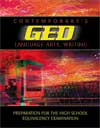|
 |  Contemporary's GED Language Arts, Writing Ellen Carley Frechette
Tim Collins
Gathering Your Ideas
Chapter OutlineStudy the chapter outline below. Use the page numbers below each topic to refer to the corresponding section in Contemporary's GED Language Arts, Writing. When you are finished, go to the Chapter Review Quiz or choose a different activity or chapter from the menu on the left.
Analyzing the GED Essay Question
(See pages 220–222)
Each GED essay question tells you the essay topic and suggests how to respond. Look for key words in the question to help you figure out what kind of response to write. | Key Words | Type of Response |
|---|
|
| | • tell whether you think | state an opinion |
| • give your views | give reasons to explain your belief | | • give reasons why | | • present your opinion | | • state whether you believe | | • state whether you agree |
|
| | • tell what happens when | state causes and effects |
| • state the effect of | | • tell the causes of | | • tell why | | • explain how |
|
| | • compare | compare and contrast two items |
| • explain the similarities and differences |
|
|
|
 |  |  | Choosing Your Main Idea
(See page 223)
-
Once you have figured out the topic of the GED essay question and how you will respond, you need to choose your main idea (the point of view your essay will develop).
-
You aren't being tested on what your opinion is. You're being tested on how well you explain your opinion and give reasons for it. Your opinion—your point of view—is the main idea of your essay.
|
|
|



 2002 McGraw-Hill Higher Education
2002 McGraw-Hill Higher Education